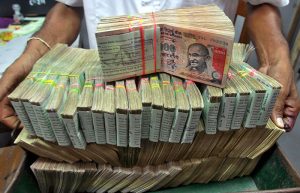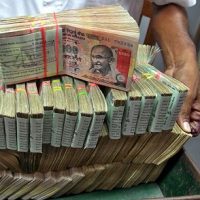Indiërs hebben bijna al het geld dat op 8 november ongeldig werd verklaard inmiddels bij de bank ingeleverd, zo schrijft Bloomberg. Dat betekent dat er nauwelijks zwart geld onderschept is, terwijl dat volgens de Indiase regering juist de reden was om alle 500 en 1.000 roepie biljetten te verbieden. Op 30 december hadden Indiase banken al bijna 15 biljoen roepie ($220 miljard) aan oude bankbiljetten ingenomen, omgerekend ongeveer 97% van alle deze biljetten die in omloop waren.
De Indiase regering verwachtte dat ongeveer 5 biljoen roepie aan zwart geld waardeloos zou worden door het afschaffen van alle 500 en 1.000 roepie biljetten, maar dat is dus niet gebeurd. De corruptie is dus zo groot dat ook bij de banken een oogje werd dichtgeknepen als er meer geld werd ingeleverd dan was toegestaan. Vermogende Indiërs bleken inventief genoeg om alle regels te omzeilen en het geld op de bankrekening te krijgen.
Kritiek
Als het doel van de Indiase regering was om de corruptie aan te pakken, dan was de operatie om bankbiljetten uit omloop te halen een grote mislukking. “De premier is slecht geadviseerd en de regering was niet voorbereid om met deze situatie om te gaan. De verwachtingen van de regering zijn niet nagekomen”, zo verklaarde Nilakantha Rath van de Indian School of Political Economy tegenover Bloomberg.
 Ook econoom Kenneth Rogoff was niet te spreken over de manier waarop India deze geldoperatie uitvoerde. In een verklaring tegenover CNBC zei hij dat de Indiase regering “zeer incompetent” te werk is gegaan en dat de operatie “behoorlijk verlammend” is geweest voor de economie. Volgens Rogoff, die zelf overigens voorstander is van een cashless society, had de Indiase regering deze operatie over een langere periode van vijf tot zeven jaar moeten doorvoeren.
Ook econoom Kenneth Rogoff was niet te spreken over de manier waarop India deze geldoperatie uitvoerde. In een verklaring tegenover CNBC zei hij dat de Indiase regering “zeer incompetent” te werk is gegaan en dat de operatie “behoorlijk verlammend” is geweest voor de economie. Volgens Rogoff, die zelf overigens voorstander is van een cashless society, had de Indiase regering deze operatie over een langere periode van vijf tot zeven jaar moeten doorvoeren.
Volgens de Harvard econoom is deze actie van de Indiase regering een voorbode op meer van dit soort maatregelen. Hij noemde het voorbeeld van Australië, dat overweegt het grootste biljet van 100 Australische dollar uit omloop te halen. Dit biljet wordt amper gebruiken voor het dagelijkse betalingsverkeer, maar vertegenwoordigt wel een aanzienlijk deel van al het briefgeld in circulatie.
Minder bankbiljetten
India is er dus niet in geslaagd zwart geld en corruptie aan te pakken, maar het is wel gelukt om meer geld op bankrekeningen te krijgen. In totaal werd er 15 biljoen aan oud briefgeld uit de economie gehaald, terwijl er slechts 8 biljoen aan nieuwe biljetten voor in de plaats kwam.
Bijna de helft van het briefgeld werd door deze ingrijpende operatie vervangen door banktegoeden. Als dat het werkelijke doel was, dan zou je de operatie wel een succes kunnen noemen.
Lees ook:
- Zit Washington achter verbod op cash in India?
- Tekort aan geld zorgt voor chaos in India
- India schrapt bankbiljetten van 500 en 1.000 roepie
Dit artikel wordt u aangeboden door Goudstandaard, uw adres voor de aankoop en verzekerde opslag van edelmetalen. Wilt u goud kopen? Neem dan contact op door te mailen naar [email protected] of door te bellen naar +31(0)88-4688488.



